Seagate's Momentus XT Reviewed, Finally a Good Hybrid HDD
by Anand Lal Shimpi on May 24, 2010 9:31 AM EST- Posted in
- Storage
- SSDs
- Seagate
- Momentus XT
- Hybrid Drive
- SSHDs
Overall System Performance using PCMark Vantage
Next up is PCMark Vantage, another system-wide performance suite. For those of you who aren’t familiar with PCMark Vantage, it ends up being the most real-world-like hard drive test I can come up with. It runs things like application launches, file searches, web browsing, contacts searching, video playback, photo editing and other completely mundane but real-world tasks. I’ve described the benchmark in great detail before but if you’d like to read up on what it does in particular, take a look at Futuremark’s whitepaper on the benchmark; it’s not perfect, but it’s good enough to be a member of a comprehensive storage benchmark suite. Any performance impacts here would most likely be reflected in the real world.
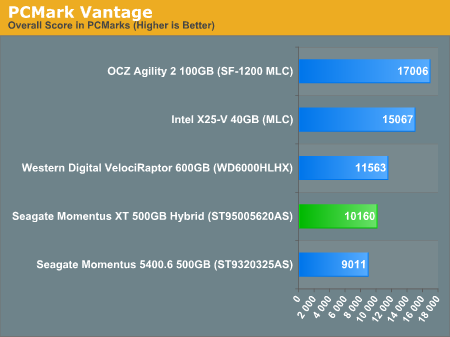
The PCMark Vantage Suite puts the Momentus XT smack in the middle of the 5400.6 and the VelociRaptor. The individual suites generally tell a similar story, although in some cases the drive actually outperforms the VelociRaptor.
The memories suite includes a test involving importing pictures into Windows Photo Gallery and editing them, a fairly benign task that easily falls into the category of being very influenced by disk performance.
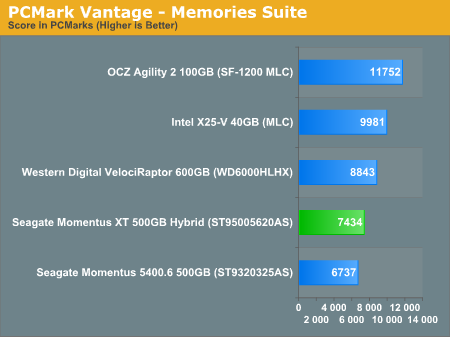
The TV and Movies tests focus on on video transcoding which is mostly CPU bound, but one of the tests involves Windows Media Center which tends to be disk bound.
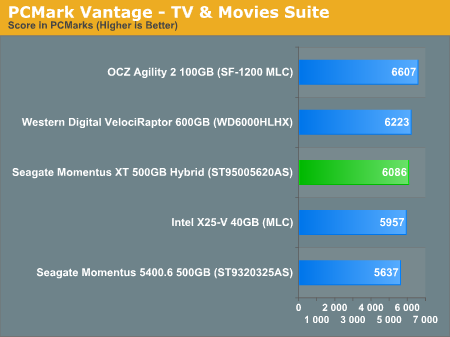
The gaming tests are very well suited to SSDs since they spend a good portion of their time focusing on reading textures and loading level data. All of the SSDs dominate here, but as you'll see later on in my gaming tests the benefits of an SSD really vary depending on the game. Take these results as a best case scenario of what can happen, not the norm.
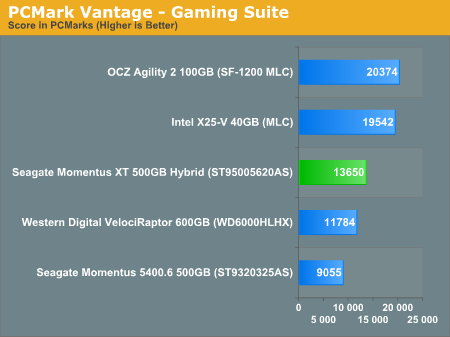
In the Music suite the main test is a multitasking scenario: the test simulates surfing the web in IE7, transcoding an audio file and adding music to Windows Media Player (the most disk intensive portion of the test).
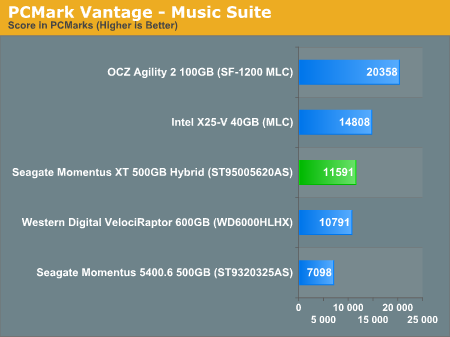
The Communications suite is made up of two tests, both involving light multitasking. The first test simulates data encryption/decryption while running message rules in Windows Mail. The second test simulates web surfing (including opening/closing tabs) in IE7, data decryption and running Windows Defender.
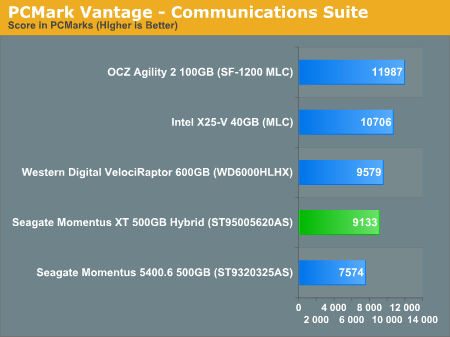
I love PCMark's Productivity test; in this test there are four tasks going on at once, searching through Windows contacts, searching through Windows Mail, browsing multiple webpages in IE7 and loading applications. This is as real world of a scenario as you get and it happens to be representative of one of the most frustrating HDD usage models - trying to do multiple things at once. There's nothing more annoying than trying to launch a simple application while you're doing other things in the background and have the load take forever.
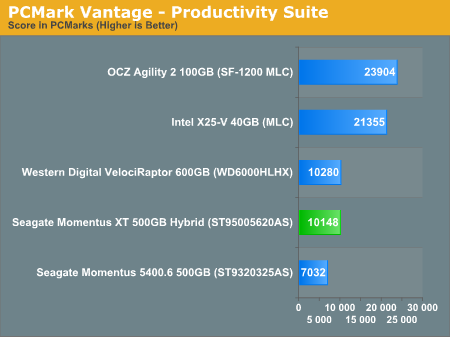
The final PCMark Vantage suite is HDD specific and this is where you'll see the biggest differences between the drives:
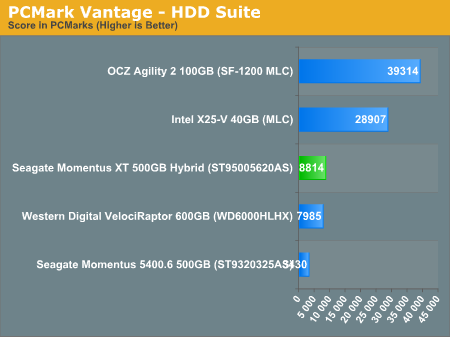










120 Comments
View All Comments
enderwiggin21 - Tuesday, May 25, 2010 - link
Almost 40% more at idle and ~33% more at load is most definitely "considerably more."Under 10% and *then* you're into the statistically insignificant category.
svend - Monday, May 24, 2010 - link
Will the NAND still be effective when using the XT with an encrypted partition/filesystem? What affect would encryption have on the performance of the XT?GullLars - Monday, May 24, 2010 - link
Thumbs up to seagate for the sollution, the one used in previous hybrids that relied on the OS was not very effective.I actually made a thread on XS forum a couple of months back discussing a sollution like this, a HDD with a NAND read-only cache using LBA read pattern mapping as caching algorithm.
In my discussion, i suggested using 8-16GB (1-2 dual plane dies) MLC ONFI 2.x NAND on a single channel for lower complexity. This would give up to about 7500 4KB random read IOPS (30MB/s), and 90-180MB/s sequential read (for cache hits). At a cost of roughly 2-3$/GB + a NAND controller, the added price tag would be around 25-50$.
I think this could be interresting for higher capacity 3,5" "black" drives as well as high-performance high capacity notebook HDDs.
auhgnist - Monday, May 24, 2010 - link
Hybrid HD seems similar to Intel Turbo Boost technology, in terms of both SSD capacity and NAND type, except that Turbo Boost allows certain level of control such as caching only data accessed some pre-given programs. Any idea how these two compare in terms of performance?joshv - Monday, May 24, 2010 - link
I mean seriously. Add another 4GB of RAM and let the OS do the caching. Sure, it won't help with boot, but for everything else it should be a lot faster than some SLC NAND on the HD.enderwiggin21 - Tuesday, May 25, 2010 - link
Or how about both?mpx999 - Monday, May 24, 2010 - link
It would be interesting to compare performance of hybrid SSD with software-based flash read cache schemes. There are basically two of them for Windows: built-in Readyboost and third-party eBoostr. Other operating systems have even better mechanisms, eg. Solaris has L2ARC caching scheme for reads and ZIL for writes.http://blogs.sun.com/brendan/entry/test
http://dotnet.agilekiwi.com/blog/2008/10/how-eboos...
Both Windows caching mechanisms can work with either USB sticks, or memory cards in built-in readers. Second option is very interesting as it means SLC flash cards can be used.
I suspect hardware controlled read-cache as implemented in this hybrid drive will totally beat Windows software -based mechanism in one important application: running virtual machines. It's because hardware cache operates on disk blocks so it doesn't matter it these blocks are from base machine or virtual machine, while software Windows mechanisms rely on file-based statistics, so they only speed up base machine. One would have to create separate cache for each VM to get speedup. Btw. software-based Solaris caching doesn't have this limitation.
vision33r - Monday, May 24, 2010 - link
It's nowhere need a true SSD in performance and just offers the cheap space of a spindle drive.The the same has having a SSD internally and carrying a spindle drive externally.
Once SSDs gets cheaper, solution like this will be less interesting.
I expect SSD prices to drop from $99 for a 40GB to like $60, then we'll see 200GB SSD for like $150 or less.
jmv2009 - Monday, May 24, 2010 - link
I don't think writing through the ssd is that important, as it can be effectively cached using the main memory of the system. Only for sustained writes >1 Gb this would become slow if the caching works well.nsravan - Monday, May 24, 2010 - link
The site had not much activity since you went on vacation. So I took one too :)